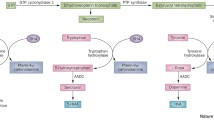Abstract
We describe two sporadic cases of dystonia-parkinsonism at different stages of disease progression. The two girls, first seen at the ages of 10 and 12 years, have been followed for 9 and 2 years respectively. In both patients L-dopa 60 mg+carbidopa 6 mg brought about a swift remission of symptoms, which persists to date. All examinations, including CT and MR brainscans, were normal. The CSF and urine levels of HVA and 5 HIAA were low in one case and normalized with treatment. This finding might provide a fairly valid predictive index of responsiveness to L-dopa.
Sommario
Gli autori descrivono due casi sporadici di Distonia-parkinsonismo in differenti stadi di progressione della malattia.
Si tratta di due ragazze viste per la prima volta rispettivamente a 10 e 12 anni e seguite per 9 e 2 anni. Dosi di 60mg di L-dopa+6mg di Carbidopa hanno determinato in entrambe una regressione pronta e completa dei sintomi che persiste a tutt'oggi.
I livelli di HVA e 5HIAA sono risultati abbassati sia a livello liquorale che urinario in un caso e si sononormalizzati con la terapia.
Questo dato potrebbe costituire un indice sufficientemente valido di predizione dell'efficacia della cura con L-dopa.
Similar content being viewed by others
References
Balottin U., Lanzi G., Zambrino C.A.:Illustrazione di un caso di Dystonia Musculorum Deformans trattato con L-Dopa. Rivista di Neurobiologia XVII-3–XVII-4:584–590, 1981.
Bedard P., Languellier P., Villeneuve A.:Estrogens and extrapyramydal system. Lancet 2:1367–1368, 1977.
De Jong A.P.J.M., Haan E.A., Manson J.I. et al.:Kinetic study of catecholamine metabolism in hereditary progressive dystonia. Neuropediatrics 20:3–11, 1989.
Deonna T.:DOPA-sensitive progressive dystonia of childhood with fluctuation of symptoms — Segawa's Syndrome and possible variants. Neuropediatrics 17:81–85, 1986.
Garg B.P.:Dystonia musculorum deformans: implications of therapeutic response to levodopa and carbamazepine, Arch. Neurol. 39:376–377, 1982.
Halliday G.M., Li Y.W., Blumbergs P.C. et al.:Neuropathology of immunohistochemically identified brainstem neurons in Parkinson's disease. Ann. Neurol. 27,4:373–385, 1990.
Nygaard T.G., Duvoisin R.C.:Hereditary dystonia-parkinsonism syndrome of juvenile onset. Neurology 36:1424–1428, 1986.
Obeso J.A., Luguin M.R., Artieda J.:Motor manifestations of basal ganglia disease. Pharmacological studies in humans. In M. Sandler et al. (Eds.) Neurotransmitters Interactions in the Basal Ganglia, Raven Press, New York, 205–217, 1987.
Ouvrier R.A.:Progressive dystonia with marked diurnal fluctuation. Ann. Neurol. 4:412–417, 1978.
Robinson R.O., Hicks B., Stuchfield P., Mardsen C.D.:A case of oestrogen sensitive dystonia. Congress of the European Federation of Child Neurology Societies, Nordwijkerhuit, Holland, may 1983.
Rolando S., Cremonte M.:Distonia progressiva con marcata fluttuazione mattino-sera. Istituto Gaslini 14:176–179, 1982.
Segawa M., Hosaka A., Miyagawa F., Nomura Y., Imai H.:Hereditary progressive dystonia with marked diurnal fluctuation. In Fahn S., Eldridge R., Adv. Neurol. 14:215–233, 1976.
Sunohara N., Mano Y., Ando K., Satoyoshi E.:Idiopathic dystonia parkinsonism with marked diurnal fluctuations. Ann. Neurol. 17:39–45, 1985.
Willemse J., van Nieuwenhuizen O., Gooskens R.H., Westernberg H.G.M.:Treatment of non-fluctuating progressive dystonia: a neuropharmacological approach. Neuropediatrics 15:208–210, 1984.
Yokochi M., Narabayashi H., Iizuka R., Nagatsu T.:Juvenile parkinsonism — some clinical, pharmacological and neuropathological aspects. Ann. Neurol. 40:407–413, 1984.
Zeman W., Dyken P.:Dystonia musculorum deforman. In Vinken P.J., Bruyn G.W. (Eds.), Handbook of Clinical Neurology. Vol. 6, Amsterdam-North Holland 517–543, 1978.
Author information
Authors and Affiliations
Rights and permissions
About this article
Cite this article
Zambrino, C.A., Balottin, U., Borgatti, R. et al. Consideration on two cases of dystonia-parkinsonism. Ital J Neuro Sci 12, 475–478 (1991). https://doi.org/10.1007/BF02335509
Received:
Accepted:
Issue Date:
DOI: https://doi.org/10.1007/BF02335509




